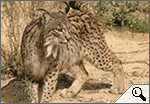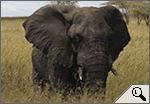|
|
|
|
 |
 |
 > Mammals Under Threat > Primates > The Good News dimarts, 14 d'octubre de 2008
The World Conservation Congress closes today in Barcelona. For ten days the Congress has hosted more than 8,000 specialists from the fields of sustainable development and biodiversity. The event was organised by the International Union for Conservation of Nature (IUCN), which is made up of over 1,000 organisations and 11,000 experts from 160 countries.
The IUCN has drawn up a Red List of Threatened Species, considered to be the most comprehensive information available on the conservation status of plants and animals. This year's Red List, announced in Barcelona, features 44,838 species, 16,928 (38%) of which are, to varying degrees, threatened with extinction. Out of these, 3,246 species fall under the category (there are several different categories) of Critically Endangered. Leaving aside the actual figures, the most remarkable piece of data refers to the proportion of mammals, some 25%, that are in danger of extinction: 1,141 species out of a total of 5,487. Worse still, this figure could reach 36% as there are 836 mammals for which there is insufficient data. Clearly, the fact that 25-36% of mammals are under threat is not due to just one cause but, rather, several: progressive destruction of habitats, hunting, pollution, etc.
Mammals Under ThreatStanding out amongst those mammals listed by the IUCN as under threat of extinction is the Iberian Lynx, of which there are only 84-143 adults—a number that has been in decline due to a shortage of its primary prey, the European Rabbit; Père David's Deer, which originated in China and is extinct in the wild; a marsupial called the Tasmanian Devil, which has seen its population drop by 60% in the last decade; the Fishing Cat, found in Southeast Asia, in decline due to habitat loss in wetlands; and the Caspian Seal, whose population has reduced by 90% in the last 100 years.
PrimatesThe situation affecting monkeys, apes and other primates is hardly any better. According to the results of a five-year long study, 48% of the 634 species of primates are under threat of disappearing. That figure rises to 70% in the case of Asia. The main threats to the survival of Man's closest ancestor are the destruction of habitat (in particular due to the burning and cutting down of tropical forests), hunting for food, and illegal trade of wild species.
The Good NewsBut it's not all bad news! According to the IUCN, 5% of wild mammals under threat are showing signs of recovery, a recovery that is possible when coordinated conservation is applied. For example, the Wild Horse has avoided extinction after successful reintroductions started in Mongolia in the early 1990s, and the African Elephant has a growing population in southern and eastern Africa.
|
Investiga

> Llista Vermella d'Espècies Amenaçades: vídeo.

> Els vint-i-cinc primats que més perillen de desaparèixer.

> Rorqual blau, mamífer amenaçat.

> Preguntes i respostes sobre l'ós blanc, o ós polar.
I també...
- L'elefant africà, mamífer de població creixent.
- Quines categories hi ha incloses en la Llista Vermella d'Espècies Amenaçades?
- Estat mundial de les espècies: una aproximació.
- Campanya d'estudi del trencalòs al Pirineu (2007).
Portada |
Europa Press |
El Punt |
La premsa |
Especials |
Diari de l'escola |
LesFinances.info |
Editorials |
Mail obert |
Els blocs |
Lletres
Tecnologia i ciència | Solidaritat | Cap de 7mana | Campus | El 9 | Presència | Fòrums | Enquestes | Xat | Correu
Traductor | Edicions en Pdf | Wap-pda | Biblioteca | Lletra més grossa
Tecnologia i ciència | Solidaritat | Cap de 7mana | Campus | El 9 | Presència | Fòrums | Enquestes | Xat | Correu
Traductor | Edicions en Pdf | Wap-pda | Biblioteca | Lletra més grossa
| Què és VilaWeb? Publicitat Mapa web Contacte | Una web de Partal, Maresma i Associats, S.L. |




